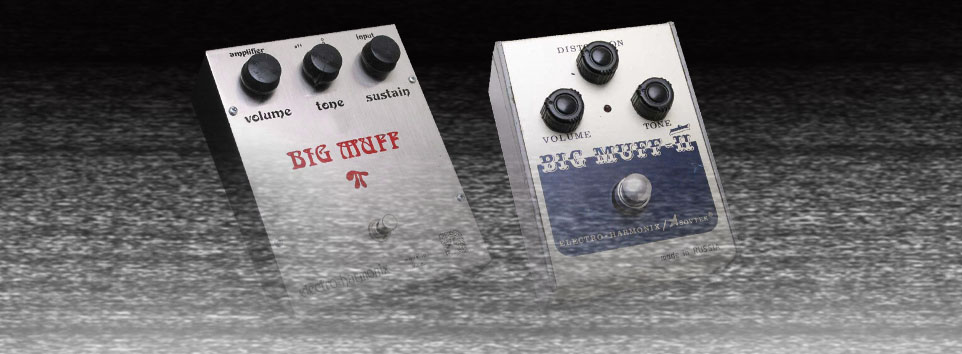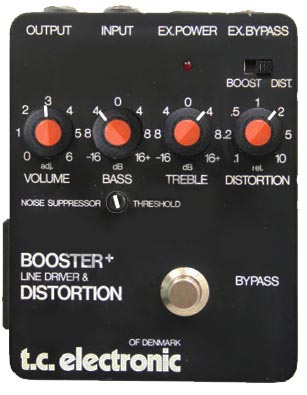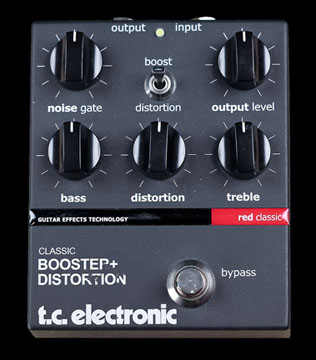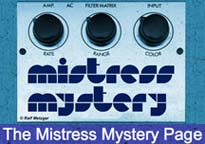NOTE: This website is frequently updated. Last update December 2019.

Big Muff Hiss Noise - The Electro-Harmonix Big Muff is high gain circuit with two clipping stages back-to-back. It is the nature of high gain circuits like this to have hiss noise, especially when the gain/sustain is set very high. Some Big Muffs have more hiss than others, depending on the circuit. The Sovtek Big Muffs, like the Civil War, Green Russian, or Black Russian, are lower gain circuits, so they are less noisy than the Triangle or Ram's Head Big Muff circuits. But they all make noise. They are even noisier when you run them with a compressor or stack them with overdrives like Gilmour has done.

So How Does David Eliminate the Noise from his Big Muffs? He does not. Sure, he uses things in his live rigs like regulated power supplies, line drivers, and ocassionally noisless pickups to keep extraneous noise as low as possible, but none of that eliminates the high gain hiss of a Big Muff. The reality is, 90% of the time you would never be able to hear the hiss noise in a band context. You would only hear it when you and the band were not playing.
When David is not using a muff, he bypasses it or kills the volume. He always uses a volume pedal on stage, and in some of his larger stage rigs he had a volume bypass switch or master mute on his floor switcher to kill the sound when he was not playing or in between songs. If he plays a solo with a Big Muff in the middle of a song, the muff is only on for the solo, then it is bypassed so it is no loger in the signal path, or he has switched to a different patch. If it is a song like Sorrow, where there are fills and solos throughout, he rides the volume pedal up and down. The volume only comes up when he plays. If you have ever heard David play live in person, or some audience recordings of his solo or Pink Floyd live shows, you do sometimes hear the noise in between songs on the ocassional time when David hits the wrong patch or is late muting the sound after a Big Muff solo.
I've got a switch to switch the volume pedal out... And I've got a master bypass, so that I can kind of pre set a combination of things on the board before I cut them all in, and I can cut them all in at once. I just press it and the whole lot comes in together. I cut the volume control out when I am not using it. - David Gilmour Interview by Steve Rosen in 1978
When you play through traditional passive single coil pickups, you will often be hearing the muff hiss plus 60 cycle electromagnetic interference (EMI) and radio freequency interference (RFI) noise from the pickups. Possibly even hum or hiss noise from your amp. When playing at low volume, all that noise combined can sound excessive and annoying. At high volume playing - like a cranked Hiwatt through a 4x12 cab - the signal-to-noise ratio is very large so there is typically less noticeable overall noise in that setting. In other words, the noise floor from single coils and the high gain Big Muff hiss is drowned out by the loud amp volume, especially when you are hearing a whole band playing.
So what do you do to avoid the noise if you are playing alone in your home at low volume where all the noise combined is more audible?
1. Learn to use your guitar volume to kill the sound when you are not playing, get a volume pedal to do the same, or switch the muff off when not playing. Learn it. Live it. Love it. Simple as that.
2. Learn to use your other fingers or palm to mute the strings you are not playing. This becomes intuitive for most players who use high gain amps or fuzz boxes and do not want to sound sloppy, but if you have not learned to do it, start. It will not reduce high gain hiss or EMI/RFI, but it will clean up your playing by reducing the other noise from strings you are not using, especially when playing solos.
3. Use noiseless pickups like EMG-SAs or Fender noiseless pickups. They will not stop the muff hiss, but they will kill most of the other EMI/RFI pickup noise and bring the overall noise floor down.
4. It should go without saying that you should be using a clean amp for Gilmour Big Muff tones. If your amp is slightly dirty, meaning it has a little bit of distortion drive even when playing clean, that will just be amplified by the Big Muff.
5. Clean up your signal chain to reduce the other noise and the Big Muff noise won't sound as bad. Noise can enter you signal chain in many different ways. Anything you can do to keep your signal chain clean and free of EMI/RFI noise will help reduce the overall noise floor when using single coil pickups and a Big Muff. Be sure your amplifier and pedalboard are properly grounded by using one common ground, not multiple outlets. Ground loops can create a lot of excessive 60 cycle hum noise. Isolation transformers/hum reducers can also be placed in between your amp plug and the wall outlet to help minimize ground loop noise.
Avoid noisy light sources like nearby flourescent or incandescent lights that can create 60 cycle buzzing noise through your rig, especially lights with dimmers. Avoid plugging in other noisy electronic devices (televisions, computers, washing machines, et cetera) into the same outlets as you use for your amplifier or pedal power supply. Avoid cheap cables with cheap shielding or excessively long cables. Always use regulated power supplies for anything in the signal chain. Shield the inside of your pickup cavity and be sure it is properly grounded.
You may also find that EMI/RFI noise is directional. When using the noisy Strat pickup positions (1,3, or 5 in a standard Strat with RWRP middle pickup) or Tele positions (1 or 3 in a standard RWRP pickup pair) try facing different directions when playing your guitar to hear if one direction is quieter than others. Usually you will find two directions that are quieter and two that are noisier.
HUMBUCKING PICKUPS - Humbuckers are designed to cancel out the hum noise you hear with single coil pickups. They will do nothing to reduce the hiss from a Big Muff circuit, just the other noise. Because of the nature of the humbucker sound, I do not recommend them for any Gilmour tones. Single coil pickups are much more expressive and tonally accurate.
NOISE GATES - Another option is to use a noise suppressor/noise gate, and EHX actually has noise gates built in to the Deluxe Big Muf and the Sovtek Deluxe Big Muff. David Gilmour has used noise gates in his live rigs in a few instances as well, but I think that was more to prevent buzz and interference from the lighting rigs at the time.
There are drawbacks to noise gates however. A poor quality noise gate, or one set too high, can cause the sound to have a pronounced on-and-off rather than a smooth fade off or on as the gate opens and closes. The sound can cut in and out when you play quietly, or kill the beginning of a note when you start to play. Or it can kill it as it is trailing off, minimizing your sustain. A sound that shuts off intermittently, rather than decaying naturally, can be just as annoying as the hiss. Some noise suppressors filter out the hiss sounds by filtering our some of the high frequencies, so the overall tone is actually altered. Higher quality noise gates can be more effective at suppressing just the hiss noise and more smoothly reducing the sound to off.
The noise gates in the EHX Deluxe Big Muffs are not particularly good in my opinion. I never had a need for noise gates myself, but there are good ones on the market like the MXR Smart Gate, Boss NS-2, or ISP Decimator. One pedal that David has used in the past that had a very good built-in noise gate was the TC Electronic BLD (Booster + Line Driver & Distortion), or BLD for short. David used it as an overdrive in the 1987-89 period, but it blends very well with a Big Muff. When combined, the noise gate has a very natural sound, effectively reducing the noise while allowing an additional range of EQ controls for the Big Muff. BLDs are rare and can be expensive to find now, but PastFX made a very good clone called the BLD in 2024.



(above left) TC Electronic BLD (Booster + Line Driver & Distortion), or BLD for short.
(middle) The TC Classic Booster + Distortion is a reissue of the original BLD that was briefly made around 2011.
(right) The PstFX BLD clone of the original TC BLD.
Kit’s Secret Guitar, Gear, and Music Page
Guitar stuff, gear stuff, soundclips, videos, Gilmour/Pink Floyd stuff, photos and other goodies.
Copyright Kit Rae.
VISIT MY SWORDS, KNIVES and FANTASY ART WEBSITE www.kitrae.net












